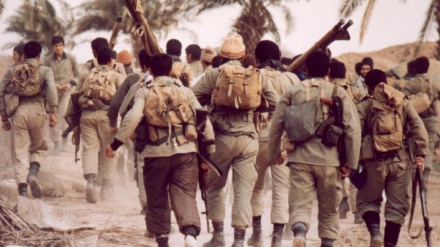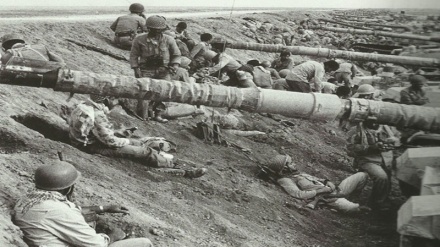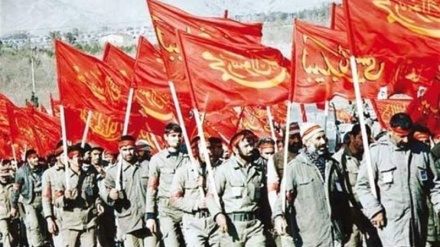Glimpses of Epic of 8-Year Holy Defense (5)
The Ba'athist regime of the former Iraqi dictator Saddam, after broad consultation with US officials garnered full information on military, political and economic power of Iran after the revolution.
Thus, Saddam launched his all-out invasion of Iran from the air, sea and land on September 22, 1980. Just five days before the invasion of Iran, Saddam regime annulled the 1975 Algiers Accord claiming that Iraq enjoyed full dominance over Arvand River (Shat al-Arab as the Arab countries call the waterway). Back in 1975, Saddam had solved the Iraqi border dispute with Iran in the Algerian capital and signed the Algiers Accord with the Iranian Shah. But five years later, Saddam breached the agreement thinking that the military balance had changed in favor of Iraq.
The Iraqi ground forces in the beginning of the invasion of Iran consisted of over 48 units of 12 divisions, including 5 infantry units, 5 armored divisions and 2 mechanized troops, as well as 15 independent brigades. There were 10 infantry brigades, 1 armored brigade, 1 mechanized brigade and 3 Special Forces brigades, plus the 10th Presidential Guard Brigade and also the Iraqi border guard forces. The Iraqi military machine was equipped with 800 cannons, 5,400 tanks and personal carriers, 400 anti-aircraft cannons, 366 fighters and bombers and 400 helicopters. Iraq's objectives in this invasion, in view of common interests with the US to contain the Islamic Revolution, as well as the expansionist ambitions of the Ba'athist regime for exploiting the vacuum caused by the overthrow of the Shah's regime can be divided into three levels. The first objective was the abolition of the Algiers Accord, which he did five days before invading the Islamic Republic of Iran by tearing the accord in front of TV cameras. The second objective was the dismemberment of Iran and separating Khuzestan province and the third objective was to overthrow the Islamic Republic of Iran.
Meanwhile, cancelation of Algiers Accord and Iraq’s full domination over Arvand River were the primary objectives of the Iraqi regime; so that if they were achieved, the overthrow of the government and dismemberment of Iran would be pursued. The unilateral cancelation of Algiers Accord was possible without a full-scale assault, but the goal of Iraq was beyond this. The Ba'athist regime in Iraq thought that the invasion of Iran could pave the way for the regime to reach the waters of the north of the Persian Gulf. The only way of Iraq’s access to the Persian Gulf waters is through Arvand River. The Ba'athist regime of Saddam believed that it would be able to dominate the Persian Gulf by invading Iran and separating Khuzestan province.
Due to its strategic features, Khuzestan province could materialize an important part of Iraq's objectives in invading the Islamic Republic of Iran.
The regime of Saddam, in view of the objectives that it had designed for invading the Islamic Republic of Iran, applied the most equipped and powerful army division for occupying the oil rich province of Khuzestan. The mission of the 9th Armored Division of Iraq was to occupy the city of Ahwaz, the capital of Khuzestan province. The 5th and first Iraqi divisions came from different routes with the help of the 9th Armored Division. The 3rd Armored Division and the 33rd Special Forces of the Iraqi Army were tasked with the siege and capture of the city of Khorramshahr, crossing the Karun River, and then occupying Abadan. The 3rd Armored Division moved 15 kilometers north of Khorramshahr to the Karun River, and at the same time the 33rd Special Forces Brigade started its advance towards Khorramshahr. Stiff resistance in Khorramshahr led to an undeniable delay in the movement of the 3rd Division, resulting in failure.
A popular resistance against the Iraqi army was formed across the Khuzestan Front. Meanwhile, the military units of the Islamic Republic of Iran based in Khuzestan played a significant role in preventing the advance of the Iraqi army and then pushing it back. This resistance prevented the fall of Ahwaz and Abadan. The Iraqi forces advanced up to 15 km from Ahwaz and besieged Abadan. In this stage of the invasion of the Islamic Republic of Iran’s soil, what is prominent is the courage and self-sacrifice of the Iranian youths from every strata and all parts of Iran to repel the invading Iraqi army. With the release of news of the Iraqi invasion of Iran, thousands of Iranian youths from all over Iran, with the least military equipment came to the battlefronts especially Khuzestan province to defend their homeland.
Meanwhile, the exemplary resistance of the youths of Khorramshahr against the aggression of the Iraqi army with empty handed gained eternity in the history of eight-year holy defense. The young men and women of Khorramshahr resisted for 35 days against numerous armed-to-the-teeth Iraqi armored and infantry brigades and troops and prevented their entry to the city. One of Saddam's army commanders, who lost hope of progressing in Khorramshahr port, after confronting the unexpected resistance of Muslim combatants, reported his situation as follows: "In the beginning, resistance was not so intense. Our unit in the center of the port city was trying to advance, but due to the stiff resistance of the Iranian forces, it only advanced a very short distance."
In such circumstances, the commander of the invading forces in Khorramshahr, while requesting assistance from the 3rd Division, acknowledged his failure in the mission. The 3rd Division, promising to dispatch Auxiliary Force, ordered that the status quo should be maintained and also ordered the advance toward Khorramshahr to a force consisting of Al-Hassan Tank Battalion and the 3rd brigade of 15 mechanized brigades and Battalion 1 of the 49th Brigade.
FK/RM/EA


